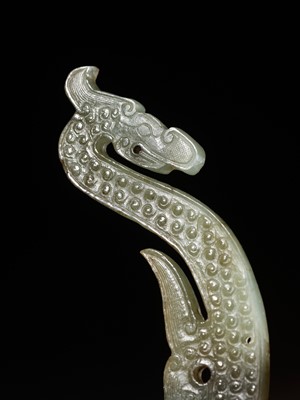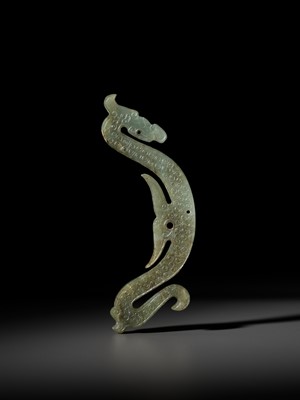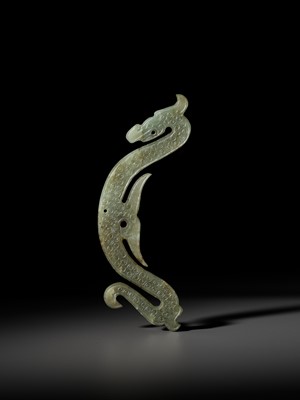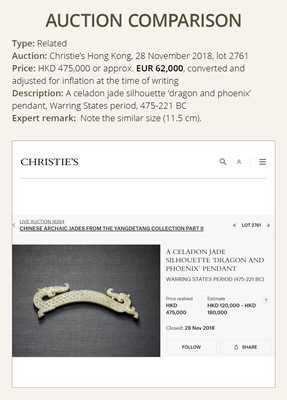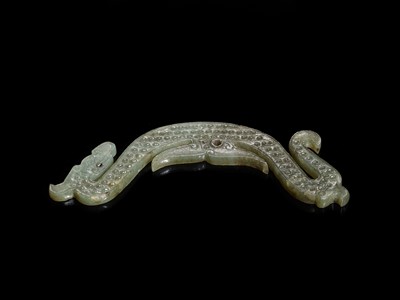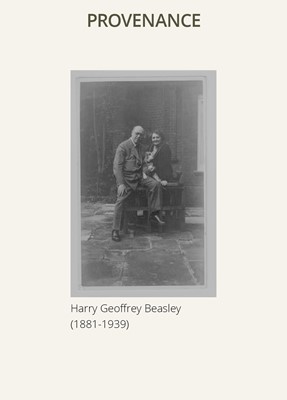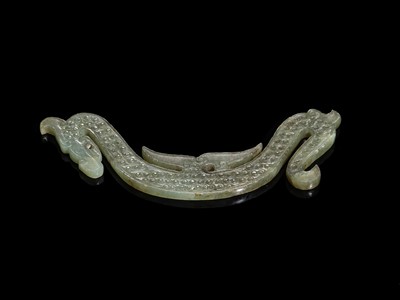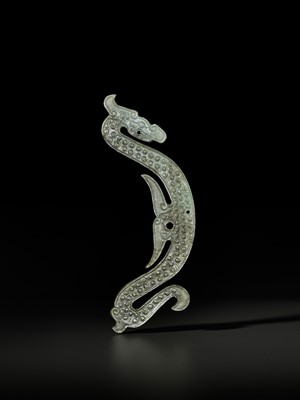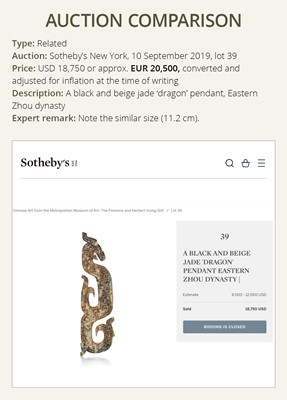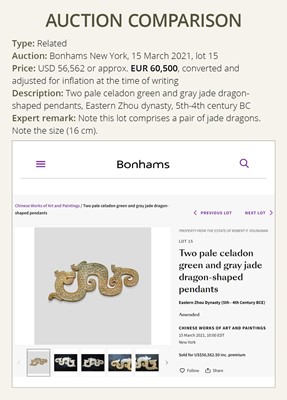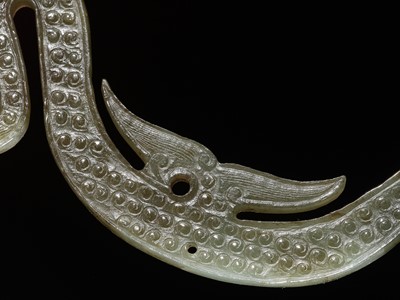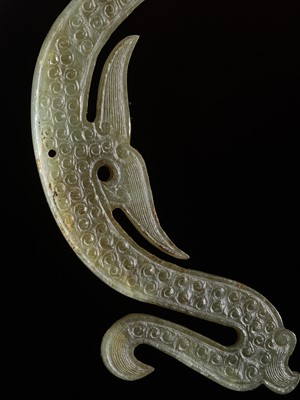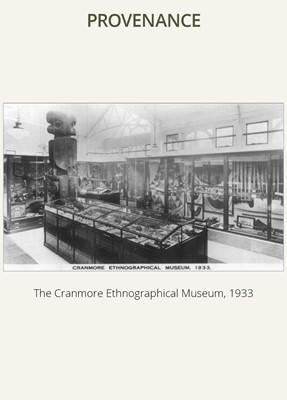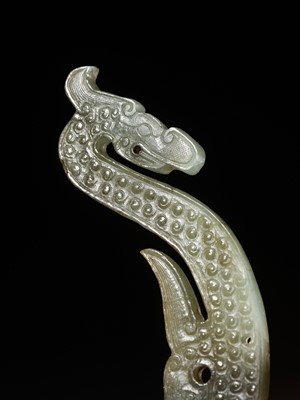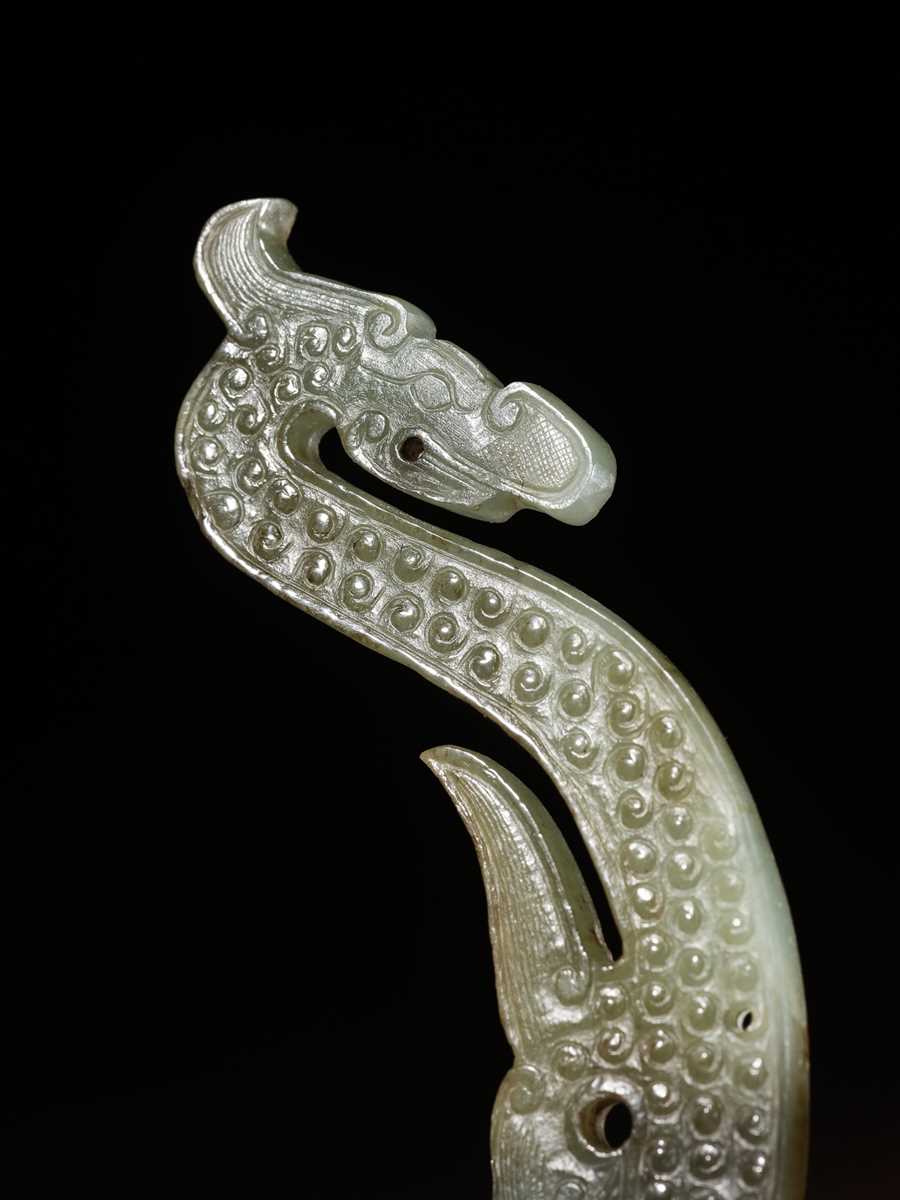1st Mar, 2024 10:00
The No Reserve Dragon Sale
67
A GREEN JADE ‘DRAGON’ SILHOUETTE PENDANT, MID-EASTERN ZHOU DYNASTY
東周中期龍形玉佩
Sold for €4,420
including Buyer's Premium
Please note this Lot is to be sold at No Reserve. 本拍品不設底價
China, 5th-4th century BC. Finely carved in the form of a dragon in profile with neatly incised circular eyes, curling horns, and a prominent pierced snout, the beast arching its body forward and curling its tail in an S-shape. Each side of the body and tail is decorated with raised comma spirals and pierced with two apertures. The translucent stone of a deep green color with pale brown shadings, dark specks, and russet inclusions.
Provenance: Collection of Harry Geoffrey Beasley (1881-1939) and thence by descent to his widow Irene Beasley. Collection of Alfred William Cowperthwaite (1890-1964), acquired from the above c. 1939 and thence by descent in the same family. Harry Geoffrey Beasley (1881-1939) was a British anthropologist and museum curator who developed an important ethnographic collection during the early 20th century that is now held in various British museums. With his wife Irene, Beasley set up the Cranmore Ethnographical Museum which eventually held more than 6,000 objects of ethnographical interest. The Beasleys collected objects from across Europe, buying from auction houses and local museums to expand the collection, which contained material from the Pacific, Asia, Africa, and Northwestern America. Beasley wrote numerous articles for anthropological journals and was considered an expert in his field. He died in 1939 and his collection was stored with the British Museum collections during the war, which was fortunate, as the Cranmore Museum was destroyed by bombing. After the war, substantial portions of the collection were passed to the British Museum, the Royal Museum in Edinburgh, the Museum of Archaeology and Anthropology, the University of Cambridge, the Pitt Rivers Museum, and the Merseyside County Museum. Other pieces, such as the present lot, were sold by his widow and, after her death in 1974, by their daughters. Alfred William Cowperthwaite (1890-1964) was a contributor to the Cranmore Museum and became good friends with Harry Beasley. Shortly after Harry Beasley’s death, he acquired several objects from Irene Beasley, including the present lot.
Condition: Excellent condition, commensurate with age. Old wear, signs of weathering and erosion, remnants of soil, encrustations, minor chips, minuscule nibbling to edges. The stone with natural fissures, some of which may have developed into hairline cracks.
Weight: 21.8 g (excl. stand)
Dimensions: Length 10.8 cm
Please click here to read the full description
With an associated metal stand. (2)
Literature comparison:
Compare a related jade figure of a dragon dated to the Zhou dynasty, 9 cm long, in the British Museum, registration number OA+.36. Compare a related dragon pendant dated to the Warring States period, 9 cm long, in the British Museum, registration numbers 2022,3034.147. Compare with a closely related jade dragon silhouette pendant dated to the Eastern Zhou dynasty, 10.8 cm long, in the Metropolitan Museum of Art, accession number 2009.94.
Auction result comparison:
Type: Related
Auction: Christie’s Hong Kong, 28 November 2018, lot 2761
Price: HKD 475,000 or approx. EUR 62,000, converted and adjusted for inflation at the time of writing
Description: A celadon jade silhouette ‘dragon and phoenix’ pendant, Warring States period, 475-221 BC
Expert remark: Note the similar size (11.5 cm).
Auction result comparison:
Type: Related
Auction: Sotheby’s New York, 10 September 2019, lot 39
Price: USD 18,750 or approx. EUR 20,500, converted and adjusted for inflation at the time of writing
Description: A black and beige jade ‘dragon’ pendant, Eastern Zhou dynasty
Expert remark: Note the similar size (11.2 cm).
Auction result comparison:
Type: Related
Auction: Bonhams New York, 15 March 2021, lot 15
Price: USD 56,562 or approx. EUR 60,500, converted and adjusted for inflation at the time of writing
Description: Two pale celadon green and gray jade dragon-shaped pendants, Eastern Zhou dynasty, 5th-4th century BC
Expert remark: Note this lot comprises a pair of jade dragons. Note the size (16 cm).
点此阅读中文翻译 (Chinese Translation)
東周中期龍形玉佩
中國,西元前五至四世紀。精雕蛟龍,龍眼圓睜,龍角捲曲,口鼻突出,身軀伸展向上,尾巴呈S形。龍身上修飾穀紋,並穿有兩個孔。深綠色半透明玉料,帶有淺棕色斑紋和褐色內沁。
來源:Harry Geoffrey Beasley (1881-1939)收藏,他逝世後由其遺孀Irene Beasley保存;Alfred William Cowperthwaite (1890-1964),約於1939年購於上述收藏,之後在同一家族保存至今。Harry Geoffrey Beasley (1881-1939) 是一位英國人類學家和博物館館長,他在二十世紀初建立了一個重要的民族志收藏,現在收藏在英國的各個博物館中。Beasley和他的妻子Irene一起建立了Cranmore民族志博物館,該博物館最終收藏了 6,000 多件民族志方面的物品。Beasley 收集了來自歐洲各地的物品,從拍賣行和當地博物館購買以擴大收藏範圍,其中包含來自太平洋、亞洲、非洲和美國西北部的資料。Beasley為人類學期刊撰寫了大量文章,被公認爲是該領域的專家。他於 1939 年去世,他的藏品幸虧在戰爭期間被存放在大英博物館裏,而Cranmore博物館被轟炸摧毀。戰後,大部分藏品被轉移到大英博物館、愛丁堡皇家博物館、劍橋大學考古與人類學博物館、Pitt Rivers博物館和Merseyside County博物館。其他收藏,例如現在的拍品,由他的遺孀出售,在她 1974 年去世後,由他們的女兒出售。Alfred William Cowperthwaite (1890-1964) 曾是Cranmore 民族志博物館重要支持人,也曾是 Harry Beasley的好友。在Harry Beasley去世不久,他從Irene Beasley 處購買了一些收藏,包括此件拍品。
品相:狀況極佳,有磨損、風化、土壤殘留、結殼、微小的磕損,邊緣有微小的。石料有天然裂隙,有的可能發展成細裂紋。
重量:21.8 克 (不含底座)
尺寸:長10.8 釐米
金屬底座 (2)
文獻比較:
比較一件相近的周代龍形玉佩,長9 釐米,收藏於大英博物館,館藏編號OA+.36。比較一件相近的戰國時期龍形玉佩,長9 釐米,收藏於大英博物館,館藏編號2022,3034.147。比較一件非常相近的東周時期玉龍剪影吊墜,長10.8 厘米,收藏於大都會藝術博物館,收藏編號 2009.94。
拍賣結果比較:
形制:相近
拍賣:香港佳士得,2018年11月28日,lot 2761
價格:HKD 475,000(相當於今日EUR 62,000)
描述:戰國青玉穀紋龍鳳形珮
專家評論:請注意相似的尺寸(11.5 厘米)。
拍賣結果比較:
形制:相近
拍賣:紐約蘇富比,2019年9月10日,lot 39
價格:USD 18,750(相當於今日EUR 20,500)
描述:東周玉雕龍紋珮
專家評論:請注意相似的尺寸(11.2 厘米)。
拍賣結果比較:
形制:相近
拍賣:紐約邦瀚斯,2021年3月15日,lot 15
價格:USD 56,562(相當於今日EUR 60,500)
描述:東周龍形玉佩兩件
專家評論:請注意此為一對龍形玉佩。請注意尺寸(16 厘米)。
Please note this Lot is to be sold at No Reserve. 本拍品不設底價
China, 5th-4th century BC. Finely carved in the form of a dragon in profile with neatly incised circular eyes, curling horns, and a prominent pierced snout, the beast arching its body forward and curling its tail in an S-shape. Each side of the body and tail is decorated with raised comma spirals and pierced with two apertures. The translucent stone of a deep green color with pale brown shadings, dark specks, and russet inclusions.
Provenance: Collection of Harry Geoffrey Beasley (1881-1939) and thence by descent to his widow Irene Beasley. Collection of Alfred William Cowperthwaite (1890-1964), acquired from the above c. 1939 and thence by descent in the same family. Harry Geoffrey Beasley (1881-1939) was a British anthropologist and museum curator who developed an important ethnographic collection during the early 20th century that is now held in various British museums. With his wife Irene, Beasley set up the Cranmore Ethnographical Museum which eventually held more than 6,000 objects of ethnographical interest. The Beasleys collected objects from across Europe, buying from auction houses and local museums to expand the collection, which contained material from the Pacific, Asia, Africa, and Northwestern America. Beasley wrote numerous articles for anthropological journals and was considered an expert in his field. He died in 1939 and his collection was stored with the British Museum collections during the war, which was fortunate, as the Cranmore Museum was destroyed by bombing. After the war, substantial portions of the collection were passed to the British Museum, the Royal Museum in Edinburgh, the Museum of Archaeology and Anthropology, the University of Cambridge, the Pitt Rivers Museum, and the Merseyside County Museum. Other pieces, such as the present lot, were sold by his widow and, after her death in 1974, by their daughters. Alfred William Cowperthwaite (1890-1964) was a contributor to the Cranmore Museum and became good friends with Harry Beasley. Shortly after Harry Beasley’s death, he acquired several objects from Irene Beasley, including the present lot.
Condition: Excellent condition, commensurate with age. Old wear, signs of weathering and erosion, remnants of soil, encrustations, minor chips, minuscule nibbling to edges. The stone with natural fissures, some of which may have developed into hairline cracks.
Weight: 21.8 g (excl. stand)
Dimensions: Length 10.8 cm
Please click here to read the full description
With an associated metal stand. (2)
Literature comparison:
Compare a related jade figure of a dragon dated to the Zhou dynasty, 9 cm long, in the British Museum, registration number OA+.36. Compare a related dragon pendant dated to the Warring States period, 9 cm long, in the British Museum, registration numbers 2022,3034.147. Compare with a closely related jade dragon silhouette pendant dated to the Eastern Zhou dynasty, 10.8 cm long, in the Metropolitan Museum of Art, accession number 2009.94.
Auction result comparison:
Type: Related
Auction: Christie’s Hong Kong, 28 November 2018, lot 2761
Price: HKD 475,000 or approx. EUR 62,000, converted and adjusted for inflation at the time of writing
Description: A celadon jade silhouette ‘dragon and phoenix’ pendant, Warring States period, 475-221 BC
Expert remark: Note the similar size (11.5 cm).
Auction result comparison:
Type: Related
Auction: Sotheby’s New York, 10 September 2019, lot 39
Price: USD 18,750 or approx. EUR 20,500, converted and adjusted for inflation at the time of writing
Description: A black and beige jade ‘dragon’ pendant, Eastern Zhou dynasty
Expert remark: Note the similar size (11.2 cm).
Auction result comparison:
Type: Related
Auction: Bonhams New York, 15 March 2021, lot 15
Price: USD 56,562 or approx. EUR 60,500, converted and adjusted for inflation at the time of writing
Description: Two pale celadon green and gray jade dragon-shaped pendants, Eastern Zhou dynasty, 5th-4th century BC
Expert remark: Note this lot comprises a pair of jade dragons. Note the size (16 cm).
点此阅读中文翻译 (Chinese Translation)
東周中期龍形玉佩
中國,西元前五至四世紀。精雕蛟龍,龍眼圓睜,龍角捲曲,口鼻突出,身軀伸展向上,尾巴呈S形。龍身上修飾穀紋,並穿有兩個孔。深綠色半透明玉料,帶有淺棕色斑紋和褐色內沁。
來源:Harry Geoffrey Beasley (1881-1939)收藏,他逝世後由其遺孀Irene Beasley保存;Alfred William Cowperthwaite (1890-1964),約於1939年購於上述收藏,之後在同一家族保存至今。Harry Geoffrey Beasley (1881-1939) 是一位英國人類學家和博物館館長,他在二十世紀初建立了一個重要的民族志收藏,現在收藏在英國的各個博物館中。Beasley和他的妻子Irene一起建立了Cranmore民族志博物館,該博物館最終收藏了 6,000 多件民族志方面的物品。Beasley 收集了來自歐洲各地的物品,從拍賣行和當地博物館購買以擴大收藏範圍,其中包含來自太平洋、亞洲、非洲和美國西北部的資料。Beasley為人類學期刊撰寫了大量文章,被公認爲是該領域的專家。他於 1939 年去世,他的藏品幸虧在戰爭期間被存放在大英博物館裏,而Cranmore博物館被轟炸摧毀。戰後,大部分藏品被轉移到大英博物館、愛丁堡皇家博物館、劍橋大學考古與人類學博物館、Pitt Rivers博物館和Merseyside County博物館。其他收藏,例如現在的拍品,由他的遺孀出售,在她 1974 年去世後,由他們的女兒出售。Alfred William Cowperthwaite (1890-1964) 曾是Cranmore 民族志博物館重要支持人,也曾是 Harry Beasley的好友。在Harry Beasley去世不久,他從Irene Beasley 處購買了一些收藏,包括此件拍品。
品相:狀況極佳,有磨損、風化、土壤殘留、結殼、微小的磕損,邊緣有微小的。石料有天然裂隙,有的可能發展成細裂紋。
重量:21.8 克 (不含底座)
尺寸:長10.8 釐米
金屬底座 (2)
文獻比較:
比較一件相近的周代龍形玉佩,長9 釐米,收藏於大英博物館,館藏編號OA+.36。比較一件相近的戰國時期龍形玉佩,長9 釐米,收藏於大英博物館,館藏編號2022,3034.147。比較一件非常相近的東周時期玉龍剪影吊墜,長10.8 厘米,收藏於大都會藝術博物館,收藏編號 2009.94。
拍賣結果比較:
形制:相近
拍賣:香港佳士得,2018年11月28日,lot 2761
價格:HKD 475,000(相當於今日EUR 62,000)
描述:戰國青玉穀紋龍鳳形珮
專家評論:請注意相似的尺寸(11.5 厘米)。
拍賣結果比較:
形制:相近
拍賣:紐約蘇富比,2019年9月10日,lot 39
價格:USD 18,750(相當於今日EUR 20,500)
描述:東周玉雕龍紋珮
專家評論:請注意相似的尺寸(11.2 厘米)。
拍賣結果比較:
形制:相近
拍賣:紐約邦瀚斯,2021年3月15日,lot 15
價格:USD 56,562(相當於今日EUR 60,500)
描述:東周龍形玉佩兩件
專家評論:請注意此為一對龍形玉佩。請注意尺寸(16 厘米)。
Zacke Live Online Bidding
Our online bidding platform makes it easier than ever to bid in our auctions! When you bid through our website, you can take advantage of our premium buyer's terms without incurring any additional online bidding surcharges.
To bid live online, you'll need to create an online account. Once your account is created and your identity is verified, you can register to bid in an auction up to 12 hours before the auction begins.
Intended Spend and Bid Limits
When you register to bid in an online auction, you will need to share your intended maximum spending budget for the auction. We will then review your intended spend and set a bid limit for you. Once you have pre-registered for a live online auction, you can see your intended spend and bid limit by going to 'Account Settings' and clicking on 'Live Bidding Registrations'.
Your bid limit will be the maximum amount you can bid during the auction. Your bid limit is for the hammer price and is not affected by the buyer’s premium and VAT. For example, if you have a bid limit of €1,000 and place two winning bids for €300 and €200, then you will only be able to bid €500 for the rest of the auction. If you try to place a bid that is higher than €500, you will not be able to do so.
Online Absentee and Telephone Bids
You can now leave absentee and telephone bids on our website!
Absentee Bidding
Once you've created an account and your identity is verified, you can leave your absentee bid directly on the lot page. We will contact you when your bids have been confirmed.
Telephone Bidding
Once you've created an account and your identity is verified, you can leave telephone bids online. We will contact you when your bids have been confirmed.
Classic Absentee and Telephone Bidding Form
You can still submit absentee and telephone bids by email or fax if you prefer. Simply fill out the Absentee Bidding/Telephone bidding form and return it to us by email at office@zacke.at or by fax at +43 (1) 532 04 52 20. You can download the PDF from our Upcoming Auctions page.
How-To Guides
How to Create Your Personal Zacke Account
How to Register to Bid on Zacke Live
How to Leave Absentee Bids Online
How to Leave Telephone Bids Online
中文版本的操作指南
创建新账号
注册Zacke Live在线直播竞拍(免平台费)
缺席投标和电话投标
Third-Party Bidding
We partner with best-in-class third-party partners to make it easy for you to bid online in the channel of your choice. Please note that if you bid with one of our third-party online partners, then there will be a live bidding surcharge on top of your final purchase price. You can find all of our fees here. Here's a full list of our third-party partners:
- 51 Bid Live
- EpaiLive
- ArtFoxLive
- Invaluable
- LiveAuctioneers
- the-saleroom
- lot-tissimo
- Drouot
Please note that we place different auctions on different platforms. For example, in general, we only place Chinese art auctions on 51 Bid Live.
Bidding in Person
You must register to bid in person and will be assigned a paddle at the auction. Please contact us at office@zacke.at or +43 (1) 532 04 52 for the latest local health and safety guidelines.
